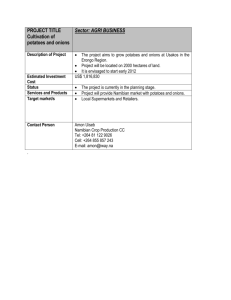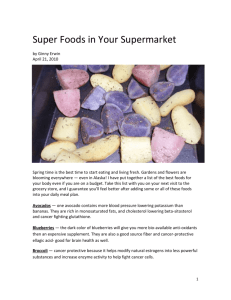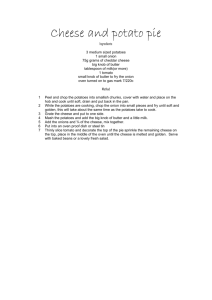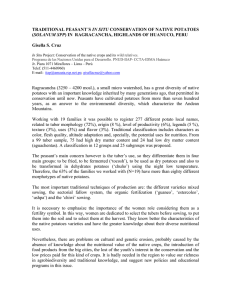TOPIC VII: The Amazing Potato and the History of Ireland
advertisement
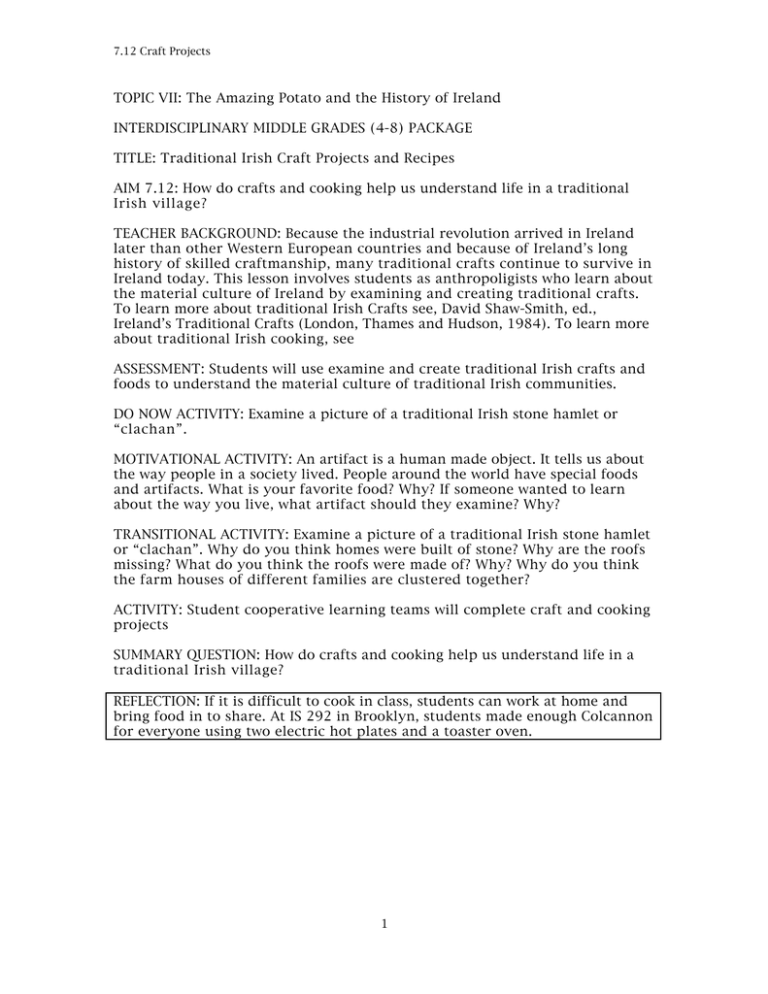
7.12 Craft Projects TOPIC VII: The Amazing Potato and the History of Ireland INTERDISCIPLINARY MIDDLE GRADES (4-8) PACKAGE TITLE: Traditional Irish Craft Projects and Recipes AIM 7.12: How do crafts and cooking help us understand life in a traditional Irish village? TEACHER BACKGROUND: Because the industrial revolution arrived in Ireland later than other Western European countries and because of Ireland’s long history of skilled craftmanship, many traditional crafts continue to survive in Ireland today. This lesson involves students as anthropoligists who learn about the material culture of Ireland by examining and creating traditional crafts. To learn more about traditional Irish Crafts see, David Shaw-Smith, ed., Ireland’s Traditional Crafts (London, Thames and Hudson, 1984). To learn more about traditional Irish cooking, see ASSESSMENT: Students will use examine and create traditional Irish crafts and foods to understand the material culture of traditional Irish communities. DO NOW ACTIVITY: Examine a picture of a traditional Irish stone hamlet or “clachan”. MOTIVATIONAL ACTIVITY: An artifact is a human made object. It tells us about the way people in a society lived. People around the world have special foods and artifacts. What is your favorite food? Why? If someone wanted to learn about the way you live, what artifact should they examine? Why? TRANSITIONAL ACTIVITY: Examine a picture of a traditional Irish stone hamlet or “clachan”. Why do you think homes were built of stone? Why are the roofs missing? What do you think the roofs were made of? Why? Why do you think the farm houses of different families are clustered together? ACTIVITY: Student cooperative learning teams will complete craft and cooking projects SUMMARY QUESTION: How do crafts and cooking help us understand life in a traditional Irish village? REFLECTION: If it is difficult to cook in class, students can work at home and bring food in to share. At IS 292 in Brooklyn, students made enough Colcannon for everyone using two electric hot plates and a toaster oven. 1 7.12 Craft Projects ACTIVITY SHEET A - Traditional Irish Craft Projects Sources: David Shaw-Smith, ed. (1984). Ireland's Traditional Crafts. London: Thames and Hudson; Lowell Thompson and Norman Machart (1982). Authentic Craft Activities to Enrich the Social Studies. Lanham, NY: University Press of America. Wool Dyeing For centuries, dyes have been extracted from the roots, stems, leaves, berries and flowers of various plants. Lichen are the oldest and most popular materials for dye. It is a plant composed of fungus and algae that grow on rocks and trees. Often it was a child's job to go out after the rain to collect lichen for dyeing. Vegetable substances commonly used in homespun dyeing include: Onion skins can be used to dye wool brown. Indigo or black berries for blue or blue-black. Heather for Yellow. Madder for Red. Dying was traditionally a woman's task. It was considered unlucky for a male to be present while the dye pot was being used. According to a popular legend, 6th century St. Ciaran of Clonmacnoise put a curse on the dyepot because his mother ordered him to leave the room while she completed her tasks. Crios Weaving (Aran Islands) On Aran Island in County, weavers make multicolored woolen belt sashes. Seven or eight pieces of wool thread are stretched between two chairs or stools. It is customary to have two white threads on the outside and five or six different colors in between. A wool belt for a man is usually 3 1/2 yards long, for a woman it is 2 yards long. After the crios is woven, each end if finished with three plaits or braids. Because the belts are so long, they are wrapped around your waist more than once. Bodhrán Irish musicians play a wood and skin frame drum called the Bodhrán that originated in ancient times. The frame is usually made from beechwood and the skins are either goat or deer. The skins are attached to the frame using glue and brass upholstery nails. Wooden cross pieces are attached to the inside of the frame to keep it from losing its shape. Musicians hold one hand between the cross pieces and the skin and beat the other side of the skin and the wooden frame with a wooden beater. Materials 1 36" x 2" x 1/16" piece of balsa wood 1 36" X 2" x 1/4" piece of balsa wood wax paper, staples, thumb tacks, scissors, serrated knife or craft saw, unsharpened pencil. 1- Soak the 1/16" piece of balsa wood in hot water until it bends easily (between two and three hours). Gradually bend the balsa wood until it forms a circle. Overlap the ends by about 4 inches. Staple the ends together. This will make a circle with a diameter of approximately 10 inches. 2- Measure in place a piece of the 1/4" balsa wood equal to the diameter of the circle (approximately 10"). Cut with the serrated knife or hobby saw. From the center of the wood, use the serrated knife or hobby saw to remove a 1/4" wide, 1 inch deep piece of wood. Use thumb tacks to anchor the support piece to the frame. 3- Measure in place a 2nd piece of the 1/4" balsa wood equal to the diameter of the circle (approximately 10"). Cut with the serrated knife or hobby saw. Line it up so it crosses the other support piece at right angles. Mark off where crosses the other support. Use the serrated knife or hobby saw to remove a 1/4" wide, 1 inch deep piece from the wood. Slide it over the other support and use thumb tacks to anchor the cross piece to the frame. 2 7.12 Craft Projects 4- Role out a sheet of wax paper four inches longer than the diameter of the circle. Center the circular frame on the wax paper. Pull tight and staple the wax paper to the circular frame. Staple around the entire circular frame. 5- Use the eraser end of unsharpened pencil as the beater. Straw Crafts Traditionally, the most common type of roof on an Irish farm house was a thatched roof made of straw. Because of the damp climate, the roofs must be regularly maintained. The most popular types of straw to use for thatching comes from wheat, rye, flax, or oat plants. Ideally, it should be gathered from fields after the plants are fully ripened but before they are cut down, or they should be taken from a field of grain that has been cut but not threshed by a combine. It is important not to break the straw. Sometimes rushes, reeds and tough grasses are substituted for straw, depending on local conditions. Straw is also used to make baskets, brooms, chair seats, braided belts, religious ornaments, and children's toys called Corn Dollies. In the British Isles “corn” refers to all grains, not maize or Indian corn. In Ireland, corn dollies and ornaments are associated with the celebration of St. Brigid's Day in February and harvest festivals. Children make St. Brigid's Crosses (Cros Bride) to hang for good luck, St. Brigid dolls, and braided straw belts (Crios Bride). Sometimes boys gave corn dollies to girls that they had a crush on. If straw has been harvested from a field, remove grain heads from the straw. Cut off pieces between the joints. Slip the husk off and trim pieces to uniform lengths. Straw is also available at craft shops. Soak the straw in warm water overnight to make it softer and flexible. Materials: Straw or reeds, sharp scissors, needles, thread, lightweight craftwire, garbage bag ties, or jute twine, pieces of yarn for trim, wire cutter, long-nosed pliers ( Thisle twine made of paper - can be substituted for the straw or reeds. It is easier to work with for younger children and does not have to be soaked.) Cros Bride (St. Brigid's Cross) 1- Cut twelve 12" long pieces of straw or reed. Soak overnight to soften. 2- Make bunches of 3 pieces. Bend the first bunch around a pencil and hold the ends with a rubber band. Bend the next bunch around a pencil. Weave the three straws through the first bunch at a right angle. Attach the ends with a rubber band. Bend the next bunch around a pencil. Weave the three straws through the second bunch at a right angle. Attach the ends with a rubber band. Bend the final bunch around a pencil. Weave the three straws through the bunch at a right angle. Attach the ends with a rubber band. 3- Pull on each bunch to tighten the weave. Use jute string to tie the end of each bunch and cut away the rubber bands. Loop a piece of string through one of the bunches to make a hanger. Corn Dollies 1- For the body, cut 5 straws that are at least 12 inches long. Soak overnight to soften. 2- Bend the softened straws around your finger and bind both "legs" with wire or jute twine leaving a gap of about 1/4". The loop forms the head of the doll. 3- Arms are made by binding two 8 inch pieces of straw at the ends with wire or string. Insert the arms through the body below the head and attach with wire or string. 4- To make the skirt, fan out the straw that forms the "legs". Loop wire or a 6 inch piece of straw around and between the strands so they remain in a fanned out position. 3 7.12 Craft Projects Crios Bride (St. Brigid's Belt) 1- Select three long pieces of straw that are not the same size. Attach one end of the three pieces using string or wire. Braid the straw gradually adding in new pieces until the braid is long enough to use as a belt. 2- As an option, attach both ends of a two-foot long garland of straw to make a circle. Make two seven inch long braids of straw. Attach to the circle with wire or string to make a cross. Dip Candlemaking Candlemaking is a craft that dates back to ancient times. Before electricity, people depended on candles to light their homes. In Europe, candlemaking was perfected during the Middle Ages. Candles were generally made from tallow (animal fat) or beeswax. Beeswax candles were more expensive to make and were generally reserved for religious use. Materials: Electric hot plate, two-quart pan, 2 coffee cans, pencils, wick, paraffin. 1- Put a quart of water in two-quart pan and heat the water to a soft boil. Put a chunk of paraffin in the coffee can and place the can in the pan of water. Lower the heat and wait until the paraffin melts. 2- Fill the second coffee can three-quarters of the way full with cold water. 3- Tie an eight to ten inch length of wick around a pencil. Tie a knot in the other end of the wick. 3- Quickly dip the wick in and out of the melted paraffin. Dip into the cold water. Repeat the process over and over again so that the wax builds up on the wick. Occasionally, shape the wax by rolling it between your hands. 4- When the candle is a satisfactory size, cut it off the pencil leaving about 1/4 inch of wick exposed. Candles can be "mass produced" by attaching more than one wick to a pencil. 4 7.12 Craft Projects ACTIVITY SHEET B - TRADITIONAL FOODS OF IRELAND These recipes are modified from the origninal. Many are adapted from A Taste of Ireland, Irish Traditional Food, by Theodora Fitzgibbon (Pan Books Ltd., London). Irish Potato Soup Ingredients 2 lb. potatoes (6 medium potatoes) 2 tbs. butter 6 cups skim milk or a mixture of whole milk and water chopped chives or parsley 2 medium-sized onions or leeks 1 cup light cream 6 strips bacon, crisply fried and crumbled (optional) salt and pepper to taste Steps 1- Peel and slice potatoes. Peel and slice onions. 2- Melt butter in a saucepan. Add the onions (or leeks) and cook gently until soft. 3- Add potatoes and season to taste. Stir. 4- Add milk or milk water mixture. Cover the saucepan. Cook over low heat one hour. 5- Prepare bacon. 6- Puree potato-onion mix in a blender. Add cream and reheat. 7- Serve sprinkled with chopped chives or parsley and bacon. Boxty Pancakes Boxty Pancakes are a traditional Irish potato dish served on the eve of All Saints’ Day, All Hallows’ Eve. Boxty can also be baked as a kind of potato bread. Ingredients 1 lb. potatoes (3 medium potatoes) 4 cups flour salt and pepper 2 cups cooked mashed potatoes 1/4 cup melted butter or margarine 1 tsp. baking soda Milk or water Vegetable oil, butter or margarine Steps 1- Peel and grate potatoes. Drain liquid. 2- Mix grated potatoes, mashed potatoes, flour, salt, pepper, melted butter or margarine, baking soda and enough water or milk to make a thick batter that will still pour. 3- Lightly oil a frying pan. Spoon mixture on the pan. Cook both sides over a moderate heat. 4- Serve with butter or sprinkled with sugar. 5 7.12 Craft Projects Colcannon (Potato and Cabbage Casserole) Ingredients 1 lb. potatoes (3 medium potatoes) 4 cups water 1 lb. green cabbage (1/2 medium head) 1 large onion 1/4 cup skim milk 1 tbs. butter or margarine salt and pepper to taste Steps 1- Boil potatoes in lightly salted water for 40 minutes until they are very tender but not mushy. Drain the potatoes and save the cooking liquid. Set the potatoes aside to cool. 2- Shred the cabbage. Chop onion. 3- Use the potato water (add more water if necessary to cover the vegetables) to boil the cabbage and onion for about ten minutes until softened. Drain the vegetables and set them aside. 4- When the potatoes are cool enough to handle, peel off the skin, place the potatoes in a bowl, add the milk and margarine, and mash them until they are smooth. 5- Add the boiled cabbage, onion and salt and pepper to the potato mixture. Mix. 6- Transfer to a greased baking dish. Before serving, heat in a moderately hot oven (15 minutes at 350°). Potato Cakes Ingredients 1 1/2 cups mashed potatoes 2 cups flour 2 tbs. butter or margarine 1 ts. baking powder 1/2 ts. salt 1/4 cup milk caraway seeds (optional) Steps 1- Mix butter, flour and salt. 2- Add mashed potatoes and enough milk to make a soft dough. 3- Roll out on a floured board. Cut into rounds about 3 inches across. Sprinkle a few caraway seeds on top of each cake. 4- Place on a oiled baking sheet. Bake at 450° for 20-30 minutes. 5- Makes nine cakes. Eat them hot, split across the middle and spread with butter. Baked Onions Ingredients 1 large onion per person a little water Steps 1- Put the onions in a baking tin, unpeeled, with about 1 inch of water. 2- Bake in a slow to moderate oven (250° F.) for 1 1/2 - 2 hours or until they are soft when you squeeze them. 3- To eat, the brown skin is pulled back and cut off and the onion is eaten with salt and pepper and a pat of butter. One of the most delicious ways of serving onions. 6 7.12 Craft Projects Pratie Oaten Ingredients 2 cups warm mashed potatoes 1/2 cup melted butter 1 cup fine oatmeal salt Steps 1- Mix oatmeal and potatoes to form a fairly soft dough. Add salt and melted butter. 2- Scatter plenty of oatmeal on a board and roll out the dough. Cut into shapes. 3- Cook on both sides on a hot greased griddle or in the oven. Serve hot. Makes 15. Irish Stew Traditionally made with either mutton or goat, potatoes and onions. A good Irish stew should be thick and creamy, not swimming in juice like soup. Ingredients 3 lbs. mutton or goat 2 lbs. potatoes (6 medium potatoes) 1 lb. onions 1/2 tbs. chopped parsley 1/2 tbs. thyme 2 cups water salt and pepper to taste Steps 1- Trim fat and bone off the meat. Cut into fairly large pieces. 2- Peel and slice the potatoes and onions. 3- Put a layer of potatoes in a pan, then herbs, then sliced meat, then onions and then another layer of potatoes. Add salt, pepper, parsley and thyme. Add water and cover. 4- Either bake in the oven at 250° F. or simmer on top of the stove, for about 2 hours. 5- Stir and add a little more liquid if it seems to be getting very dry. Champ Ingredients 1 1/2 lbs. potatoes (4 or 5 medium potatoes) 10 scallions or 2 leeks 1/2 cup of milk salt and pepper to taste 4 tbs. melted butter Steps 1- Boil potatoes. Peel and mash. 2- Chopped scallions or leeks. Cook in the milk until soft. Drain, but save the milk. 3- Add scallions or leeks and salt and pepper to the mashed potatoes. Beat well. 4- Add enough milk to make the dish creamy and smooth. 5- Put mixture into a deep warmed dish. Make a well in the center. Pour hot melted butter into the center. 7 7.12 Craft Projects Oaten Honeycomb Ingredients 2 cups flaked oatmeal 1/2 cup finely chopped almonds 2 cups milk 3 tbs. sugar 1/4 ts. ground cinnamon 3 eggs 2 tbs. honey 2 tbs. raisins 3 tbs. melted butter Steps 1- Bring the milk to a boil and add oatmeal. Lower flame and cook for 15 minutes, stirring all the time. Allow to cool. 2- Separate egg yolks and egg whites. Beat. 2- Add almonds, honey, sugar, raisin, cinnamon, melted butter and egg yolks. Mix well. Add the stiffly beaten egg whites. 3- Poor into a buttered bowl, cover and steam over hot water for 1 1/2 hours. Yellowman Toffee Ingredients 1 1/2 cups light corn syrup 1 cup brown sugar 1 tsp. baking soda 1 tbs. butter 2 tbs. vinegar Steps 1- Melt the butter in a pan over low heat. Add sugar, syrup and vinegar. Stir until all ingredients are melted. 2- Boil without stirring until a little of the toffee becomes crisp. Add baking soda, which will make the mixture foam up. Stir. 3- Pour toffee into a large dish. Turn edges to the center and allow to cool. Pull the toffee when cool enough until it is pale yellow in color. It can cut into squares if preferred. 8
